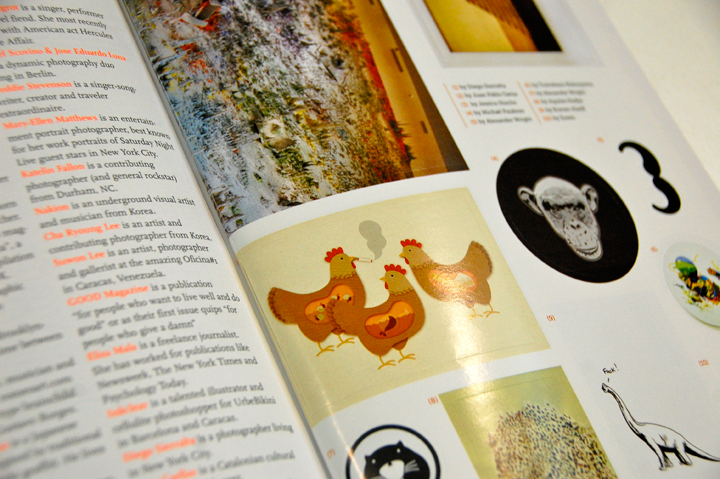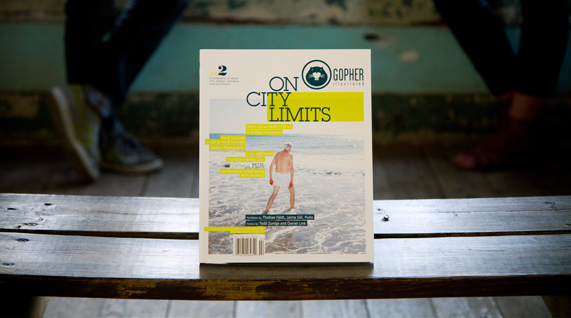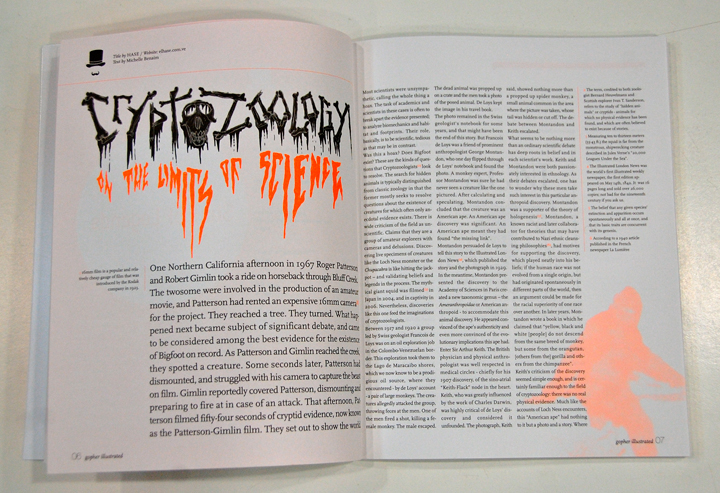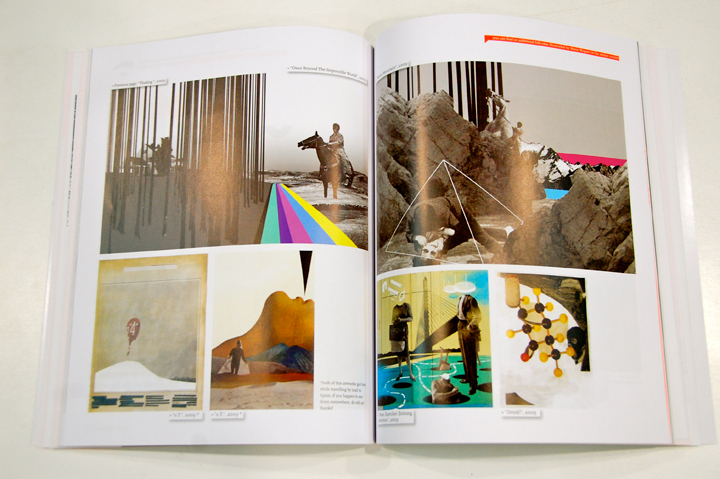

Starting a print magazine in an era of digital media is a labour of love and passion. Editors Lope Gutiérrez-Ruiz and Michu Benaim Steiner from Austin’s Gopher Illustrated took it to the next level by making every issue hand made. 1000 copies with stickers, a blank page for you to draw and personalise your copy and advertisers also get to have their ad inserted one by one with the possibility to also to experiment with personalised advertising. Q & A with the editors.
Baron : Each magazine is hand numbered; letter-pressed and distributed to targeted audiences… just amazing… can you tell us more about this way of making a magazine?
Gopher Illustrated : We believe that the magazine as simply a medium for conveying information that is quickly giving way to the faster, more efficient online medium. But the magazine as a multisensory experience, as a tactile, engaging, weighty object, an edition, full of choices and details, and frames of thought – is very much alive. A magazine is not entirely democratic and we really obsess over every detail. That’s where the idea of hand-numbering the very limited number of copies we print came into play. Since the magazine projects a bit of an editorial and artistic point of view, we thought we might treat it as one would a limited edition print. That way, the magazine is a collectible and serves for enjoyment in a number of ways. First of all is the delight of newness. Then, the content can be consumed and through the stickers in the back, modified. And lastly, there is the pleasure of collecting it, of having something that used to be an ephemeral medium take on a book-like quality.
To make this kind of magazine, the content needs to endure. We don’t focus on current events, but aim to capture a cultural snapshot of emerging talent. And that’s really what it’s all about; providing a platform that is deserving of the people whose work we feature and bringing it to a readership who will appreciate it.

B. : How did it start?
G. I. : I don’t think there’s necessarily a need for it. But both of us editors (Lope Gutiérrez-Ruiz and Michu Benaim Steiner) are lovers of magazines and both been working in the medium for a number of years. There’s something incredibly exciting in presenting something for readers. As a compulsive magazine buyer, I can tell you that for me there’s nothing better than running home and cracking open a brand-new, freshly inked, beautifully produced magazine. The only other feeling that comes close is having a memory of something you saw or read some time before and finding it again in your bookshelf. It’s kind of like rediscovering a great piece of clothing you hadn’t worn in a long time that was stuck in the back of your closet.
At the same time, we realize that most magazines and books end up either in the wastebasket or are loaned out to friends indefinitely or even in charity shops if you’ve had a fit of spring cleaning. Books, and especially magazines, have to earn the right to have a place in your shelf.

That’s the point of departure for actually making the magazine. We basically work to make a magazine that is full of exciting newer talents, that has breadth from which you emerge knowing something new and that provides a diversity of experiences. And we made exactly the kind of magazine we would kill to have.
In terms of journey, the process isn’t really all that mysterious. We request proposals, we read a ton, we sit down and scribble articles ideas, we read some more, scour the internet for portfolios, ask our friends for references, ask our references for references… and little by little we put together all the pieces we choose. It helps that we have a theme in every issue. Otherwise our heads would explode.
B. : What is your mission editorial wise…
G. I. : Our mission, generally speaking, is to provide platforms for emerging talents in visual arts, literature, journalism, and design. The aim with this is not only to showcase work that we consider to be excellent but to spark discussions around the work, its meaning and experiences. With the magazine in particular, it is to produce issues that are filled with great content that are playful, interactive, and beautiful and that endure in time. We’ve branched out and Gopher Illustrated is also involved in producing events, presenting cultural collaborations [link] and are now working on some top secret projects that we’d love to share with you once they’re better defined.

B. : Why choose print? What kind of paper you use and why? What about the typography?
G. I. : See above. We print in a great shop in Colombia and they have a very specific kind of paper stock with a proprietary name. For practical purposes, it’s an 80lb matte stock for inside pages, 80lb demi-gloss for the portfolio portion and a matte 120lb cover stock with a matte finish. The paper choice has to do with quality and endurance but we also chose what we felt was the best possible paper for reading and the best possible paper for displaying artwork (demi-gloss).Typography varies for every issue, since we invite a different illustrator or designer to produce each title for articles and so on (about 12-15 per issue, at least).
B. : How’s the public response?
G. I. : The public response has been great. People have really supported the project from the beginning (the first issue was funded through Kickstarter, back in 2009!).

B. : Good print magazines get a lot of love but that is not always translated into sales or advertising. How are the sales? Advertising wise, is it a normal approach of selling an ad page or more of a brand ad approach?
G. I. : The sales are good. We work with distributors that place the magazines in independent bookshops and we also make a good number of sales online. Since we only print 1000 copies, it really doesn’t take much for issues to sell. In terms of advertising, we approach likeminded projects and brands and see it more as a holistic partnership. We purposefully limit the number of ads in each issue since no one likes being bombarded with ads. So we only talk with potential advertisers that we feel our readers could benefit from and get behind.
B. : Can you give us a small tour of Austin’s niche media scene?
G. I. : One late great bookshop was DOMY books which has now transformed into a new shop owned by two former employees of the original. This is certainly not a giant media hub at all but there are some projects that are worth noting. There’s an art magazine called Pastelegram that is run by Ariel Evans. There’s also a bunch of ad hoc publications by design shops and artist collectives and so on.
B. : Upcoming projects
G. I. : We have a few issues of the magazine lined up and have some projects that we’re working on but are not ready for me to talk about. But we’re looking forward to chatting about them soon!





